Experimental Therapeutics
85 members representing 20 departments and centers at UT Southwestern
The Experimental Therapeutics (ET) Program provides an organized integrated infrastructure that enables both clinical translation of basic and population science research from Simmons research programs and identification of clinically relevant hypotheses for testing by the Center’s basic science programs. The Program is the main hub of cancer clinical trials in the SCCC.
The three program specific aims focus on therapeutic development and biomarker discovery, where members work collectively to: Target tumor microenvironment with immunotherapy by modulating the role of immune cells in tumor progression; Advance imaging and drug delivery by developing novel imaging and nanotechnology delivery platforms to enhance cancer diagnosis and therapy; and Exploit cancer vulnerabilities by leveraging synthetic lethalities as new “targeted” therapy for cancer.
Recognizing the critical importance of developing the next generation of cancer investigators, the ET Program mentors young investigators, works with established investigators to develop clinical translation, and partners with Cancer Research Training and Education Coordination (CRTEC) to incorporate comprehensive training, mentorship, and career development activities.
Exploit Cancer Cell-Autonomous Vulnerabilities
Under the leadership of Robert Timmerman, M.D., the UTSW Department of Radiation Oncology has developed PULSAR, a paradigm-changing radiation approach that leverages cancer cells' inherent DNA repair deficiencies and radiation sensitivity, allowing for higher effective doses while sparing normal tissues through the adaptive fractionation approach. The ultrafractionation of radiation delivery allows for personalized adjustment of the radiation field and dose based on treatment response, offering three key advantages over traditional daily fractions. Split course treatments are less toxic, long intervals between pulses facilitate adaptive doses, and these extended intervals may foster adaptive immunity. Research demonstrates that both radiation and immunotherapy sequencing, as well as radiation therapy fraction spacing, significantly affect combination treatment responses. Better tumor control was achieved by giving anti-PD-L1 therapy during or after radiation, with fractions spaced 10 days apart (PULSAR) achieving superior tumor control compared to traditional daily fractions. The study showed that CD8+ depleting antibody abrogated tumor control in PULSAR combination treatment, and certain treatment schedules induced immunologic memory.
Target the Tumor Microenvironment to Enhance Anti-Tumor Immunity and Immunotherapy
Jerry Shay, Ph.D., and colleagues have demonstrated that treatment with the nucleoside analog 6-thio-2'-deoxyguanosine (6-thio-dG) leads to telomere replication stress, resulting in increased micronuclei formation, generation of cytosolic double-stranded DNA, and cGAS-STING pathway activation. Since telomerase is active in ~85% of cancers but largely absent in normal somatic cells, this approach provides a cancer-selective therapeutic window. This process converts "immunologically cold" tumors to become sensitive to immune checkpoint inhibition by increasing both innate and adaptive immunity. In small cell lung cancer models, 6-thio-dG treatment specifically depletes cancer initiating cells (CICs) identified by their expression of L1CAM/CD133 and highest telomerase activity, while simultaneously activating type-I interferon signaling that leads to tumor immune visibility through STING pathway activation. The therapy also enhances sensitivity to radiation treatment in both syngeneic and humanized xenograft models. In hepatocellular carcinoma studies, telomere stress induced by 6-thio-dG increases both innate sensing and adaptive antitumor immunity, with extracellular high-mobility group box 1 protein acting as a damage-associated molecular pattern to elicit adaptive immunity.
Develop Imaging and Drug Delivery for Cancer Therapy
Jacques Lux, Ph.D., and his team developed MUSIC (Microbubble-assisted Ultrasound-guided Immunotherapy of Cancer), an innovative technology designed to activate STING in antigen-presenting cells and generate a potent, durable anti-tumor immune response. The approach addresses the clinical limitations of natural STING agonists like cyclic dinucleotides, which suffer from poor cytosolic entry, serum stability, low specificity, and rapid tissue clearance. The team loaded the natural STING agonist cGAMP onto clinically established microbubbles using nanocomplexes composed of cGAMP electrostatically bound to biocompatible branched cationic biopolymers. Application of external ultrasound pulses creates transient pores in antigen-presenting cell membranes through sonoporation, enabling direct cGAMP delivery into the cytosol and resulting in cGAS-STING activation. This targeted local activation leads to enhanced proinflammatory pathways that efficiently prime antigen-specific T cells, bridging innate and adaptive immunity. The technology successfully inhibited tumor growth in both localized and metastatic murine cancer models and improved the therapeutic efficacy of checkpoint blockade, demonstrating the potential for novel image-guided strategies in targeted cancer immunotherapy.
Notable Publications
Cai, L. et al. High Glucose Contribution to the TCA Cycle Is a Feature of Aggressive Non-Small Cell Lung Cancer in Patients. Cancer Discov 2025;15(4):702-16. PMCID: PMC11962397.
Hsieh, D. et al. The phosphatidylserine targeting antibody bavituximab plus pembrolizumab in unresectable hepatocellular carcinoma: a phase 2 trial. Nat Commun 2024;15(1):2178. PMCID: PMC10928173.
Hannan, R. et al. Tumor loss-of-function mutations in STK11/LKB1 induce cachexia. JCI Insight 2023;8(8). PMCID: PMC10243820.
Huang, H. et al. Cell Competition Shapes Metastatic Latency and Relapse. Cancer Discov 2023;13(1):85-97. PMCID: PMC9839468.
Sumer, B. et al. STING licensing of type I dendritic cells potentiates antitumor immunity. Sci Immunol 2024;9(92):eadj3945. PubMed: 38363830.
Leadership and Contact

Professor, Internal Medicine





